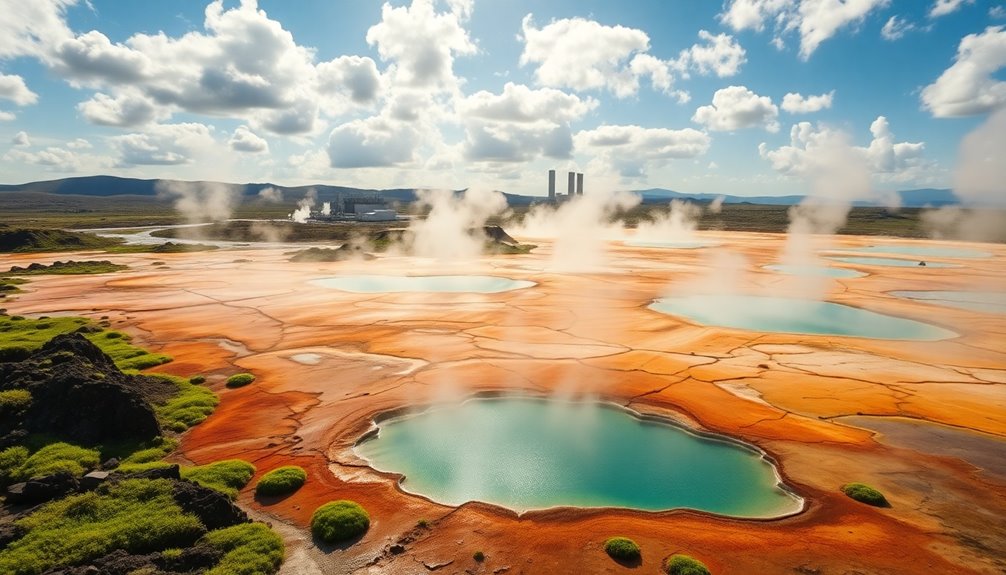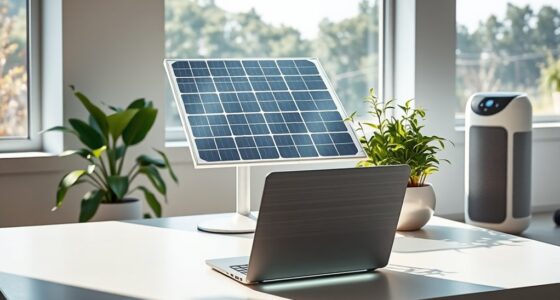Geothermal energy taps into the Earth's internal heat, giving you a sustainable power source that's available 24/7. It reduces your dependence on fossil fuels and lowers greenhouse gas emissions. By harnessing hot water or steam from beneath the surface, it drives turbines to generate electricity or heats buildings directly. Though there are challenges, like site accessibility and initial costs, the benefits make it a promising option. Discover what else geothermal energy can offer you!
Key Takeaways
- Geothermal energy utilizes Earth's internal heat, providing a sustainable and reliable power source available 24/7.
- It involves tapping into hot water or steam reservoirs, converting heat to electricity through turbines.
- Geothermal systems include ground-source heat pumps, direct-use applications, and various types of power plants.
- This energy source produces minimal greenhouse gas emissions, aiding in climate change mitigation.
- Despite its benefits, geothermal energy faces challenges such as high initial costs and resource accessibility issues.
What Is Geothermal Energy?
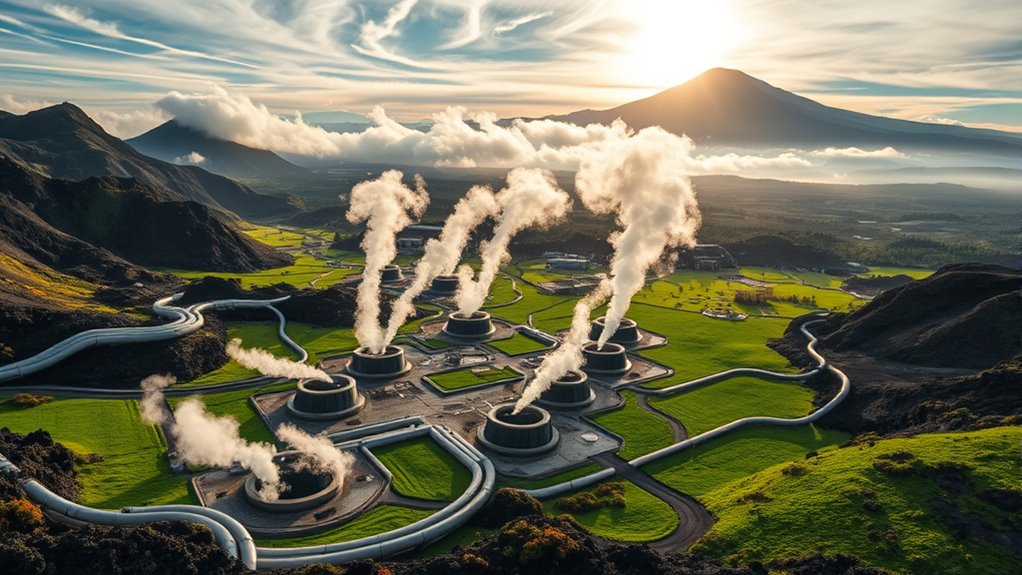
Geothermal energy harnesses the Earth's internal heat, providing a sustainable and reliable power source. You mightn't realize it, but beneath your feet lies a reservoir of thermal energy. This energy comes from the natural decay of radioactive materials and the Earth's core, creating heat that can be tapped into.
Utilizing geothermal energy means you can reduce dependency on fossil fuels and lower greenhouse gas emissions. It's not just eco-friendly; it's also consistent, as the Earth's heat is always available, unlike solar or wind energy, which depend on weather conditions.
How Geothermal Energy Works
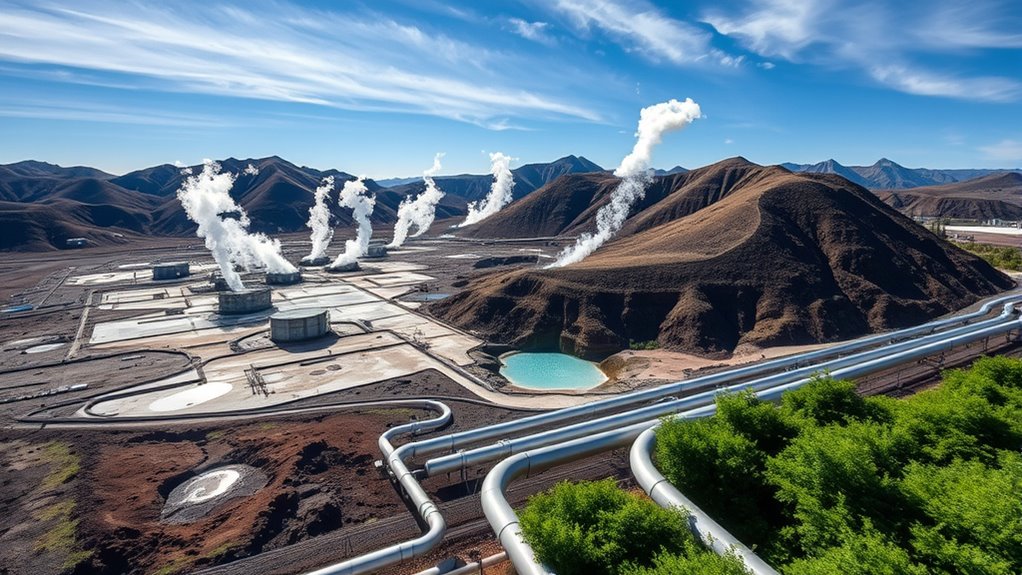
Harnessing the Earth's internal heat involves a straightforward process that transforms thermal energy into usable power.
First, you tap into hot water or steam reservoirs beneath the Earth's surface. As the geothermal fluid rises, it carries heat to the surface.
Next, you use this heat to drive turbines connected to electricity generators. If you're using steam, it directly turns the turbines; if you're using hot water, it's often turned into steam in a heat exchanger.
Harnessing geothermal energy involves driving turbines with steam or converting hot water into steam for electricity generation.
After the process, the cooled fluid is reinjected back into the ground to maintain the reservoir's pressure.
This cycle ensures a sustainable energy source, allowing you to harness the Earth's heat continuously while minimizing environmental impact.
Types of Geothermal Systems

While exploring energy options, you'll find that geothermal systems can be categorized into several types, each suited for different applications and resource conditions.
First, there are ground-source heat pumps, which use the earth's stable temperatures to provide heating and cooling for homes.
Second, there's direct-use geothermal, where hot water from the ground is utilized directly for heating buildings or greenhouses.
Then, you have geothermal power plants, which convert steam or hot water from deep underground into electricity.
These plants can be further categorized into dry steam, flash steam, and binary cycle systems, depending on how they extract and utilize geothermal energy.
Each system offers unique advantages based on specific geothermal resources and energy needs.
Benefits of Geothermal Energy

One of the most compelling reasons to consider geothermal energy is its environmental sustainability. Unlike fossil fuels, geothermal energy produces minimal greenhouse gas emissions, helping combat climate change.
You'll find that it's a reliable and consistent energy source, providing power 24/7, regardless of weather conditions. By tapping into the Earth's natural heat, you're also reducing your dependence on imported fuels, enhancing energy security.
Additionally, geothermal systems typically require less land compared to solar or wind farms, preserving natural habitats. The long lifespan of geothermal plants means lower maintenance costs over time, making it economically attractive.
Challenges and Limitations
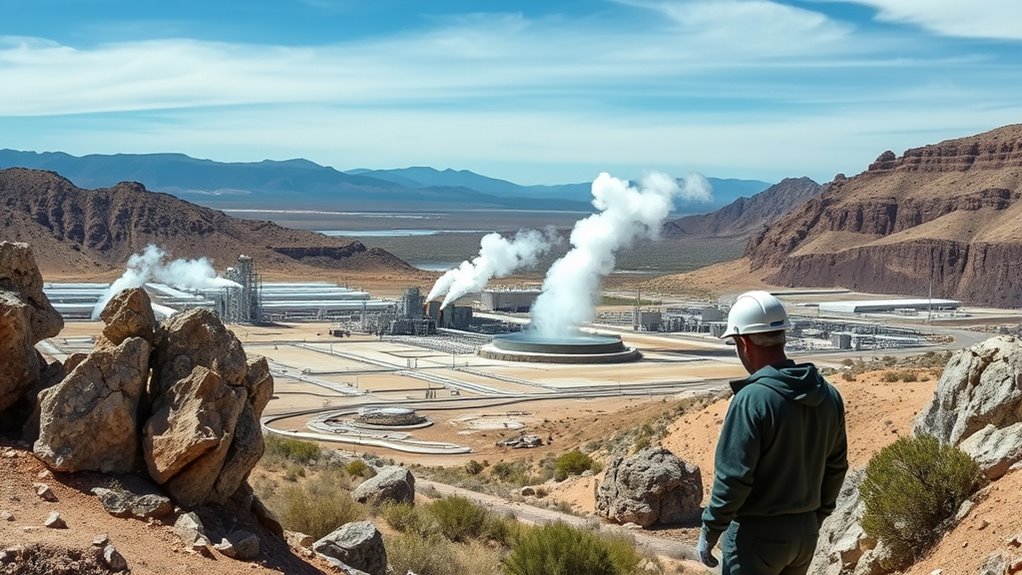
Although geothermal energy offers numerous benefits, it also comes with challenges and limitations that must be considered. One major issue is the location of geothermal resources; not every area has accessible heat sources.
You may also face high initial costs for drilling and development, which can deter investment. Additionally, the potential for induced seismicity, or minor earthquakes, raises environmental concerns in some regions.
Water usage can also be problematic, especially in areas prone to drought. Lastly, geothermal systems require continuous maintenance and monitoring to ensure efficiency and safety.
These factors can complicate the development process, making it essential for you to weigh these challenges against the long-term advantages of harnessing geothermal energy.
Applications of Geothermal Energy

As you explore the applications of geothermal energy, you'll discover its versatility in various sectors.
In residential settings, geothermal heat pumps can efficiently regulate indoor temperatures, reducing energy bills.
In agriculture, geothermal energy provides heating for greenhouses, enhancing crop yields. You might also find it used in aquaculture, where heated water boosts fish growth.
Industrial operations benefit too, utilizing geothermal energy for processes like drying and sterilization.
Additionally, geothermal energy supports district heating systems, supplying hot water to multiple buildings.
Lastly, it plays a role in electricity generation, powering turbines to produce renewable energy.
With all these applications, geothermal energy proves to be a sustainable choice for meeting diverse energy needs.
The Future of Geothermal Energy
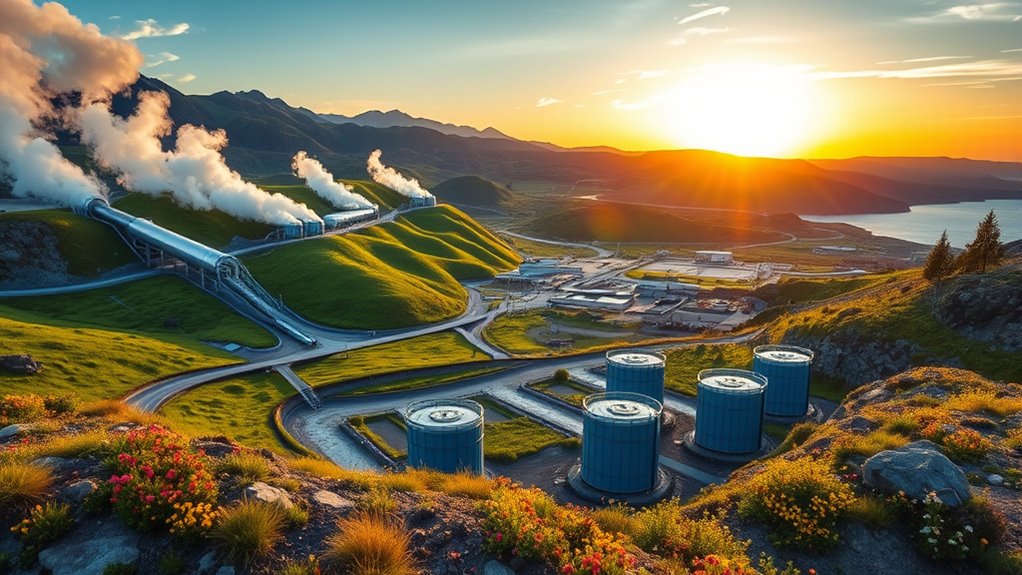
With advancements in technology and growing awareness of climate change, the future of geothermal energy looks promising.
You'll likely see continued investments in geothermal projects as the demand for clean, renewable energy skyrockets. Innovations in drilling techniques and enhanced geothermal systems are making it easier to access this sustainable resource.
As more countries recognize geothermal's potential, you'll witness a rise in the number of geothermal power plants, reducing reliance on fossil fuels.
Moreover, research is uncovering new applications, from heating buildings to powering industries.
By embracing geothermal energy, you can contribute to a more sustainable future, helping to combat climate change while ensuring energy security.
The path ahead is filled with possibilities, and your support will be essential in this transition.
Geothermal Energy Around the World
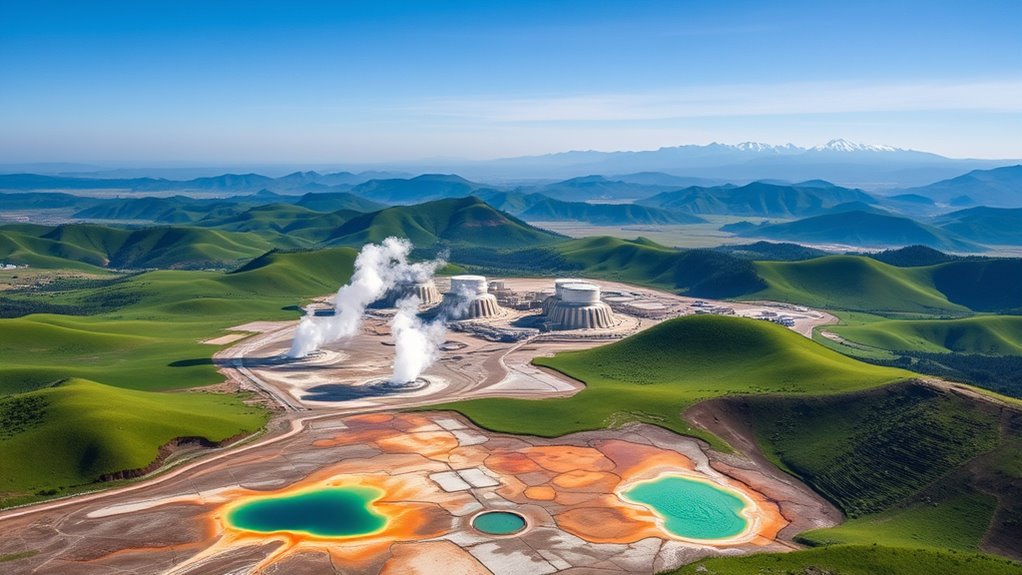
Geothermal energy is harnessed across the globe, providing a reliable and sustainable power source for many countries.
In places like Iceland, nearly 90% of homes are heated using geothermal systems, showcasing its effectiveness. The United States leads in geothermal electricity production, with California hosting some of the world's largest plants.
In the Philippines, geothermal energy contributes significantly to the energy mix, making it the second-largest producer worldwide. Countries like New Zealand and Italy also utilize geothermal resources for both heating and electricity.
As you explore the potential of geothermal energy, consider how its widespread adoption could help reduce carbon emissions and decrease dependency on fossil fuels, paving the way for a greener future.
Frequently Asked Questions
How Long Does It Take to Install a Geothermal System?
When you're considering a geothermal system, installation typically takes about one to three weeks, depending on various factors.
This includes the size of your property and the complexity of the system. You'll find that the drilling and ground loop installation processes can be the most time-consuming.
However, once the groundwork is done, the rest of the system installation goes fairly quickly. You'll be enjoying your new system in no time!
What Maintenance Is Required for Geothermal Systems?
You might be wondering what it takes to keep your system running smoothly.
Well, don't worry; maintenance for geothermal systems is pretty straightforward! You'll want to check the filters regularly and replace them when necessary, usually every few months.
Annual inspections by a professional are also essential to ensure everything's in tip-top shape.
If you stay on top of these tasks, your system will continue to efficiently provide comfort for years to come.
Can Geothermal Energy Be Used in All Climates?
Yes, geothermal energy can be used in various climates, but its effectiveness varies.
In cooler regions, it's particularly beneficial for heating, while in warmer areas, it can help with cooling.
You'll need to consider your local geology and the depth of the geothermal resources available.
Areas with stable heat sources are ideal, but even less favorable climates can still harness geothermal energy with the right technology and approach.
Is Geothermal Energy Cost-Effective in the Long Term?
You might wonder if geothermal energy is cost-effective over time. The truth is, while the initial setup can be pricey, the long-term savings often outweigh those costs.
Once established, geothermal systems typically have low operating costs and can last for decades. By tapping into the Earth's natural heat, you'll likely see reduced energy bills and less reliance on fossil fuels, making it a smart investment for sustainable living.
What Are the Environmental Impacts of Geothermal Energy?
Geothermal energy can have several environmental impacts.
You'll notice that while it produces low greenhouse gas emissions, it can cause land degradation and water depletion in certain areas.
Additionally, the potential release of harmful gases from underground reservoirs might concern you.
However, it generally has a smaller footprint compared to fossil fuels.
Balancing these factors is crucial, so you should weigh the benefits against potential risks for sustainable energy solutions.
Conclusion
In conclusion, geothermal energy offers a sustainable way to harness the Earth's natural heat, providing clean, reliable power for various applications. For instance, Iceland, a country rich in geothermal resources, generates about 90% of its homes' heating needs from this energy source. By investing in similar technologies and infrastructure, other nations can tap into geothermal energy, reducing reliance on fossil fuels and moving toward a greener future. Embracing this potential could revolutionize the global energy landscape.
